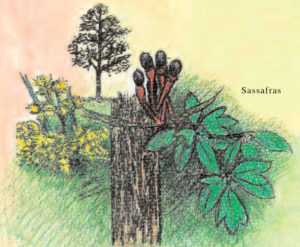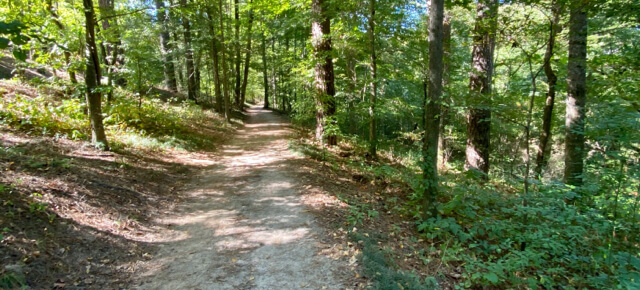Trees, Shrubs, and Vines of Jemison Park
Following is a list by family of the native deciduous and evergreen trees, shrubs, and vines that create the inviting canopy of the park. For more about trees and shrubs in the area, see Trees and Shrubs in the Heart of Dixie by Blanche E. Dean.

Pine family, Pinacae
Loblolly Pine, Pinus taeda
Shortleaf Pine, P. echinata
Bald Cypress, Taxodium distichum
Lily Family, Liliaceae
Catbriar, Smilax rotundifolia
Willow family, Salicaceae
Bayberry Family, Myricaceae
Walnut family, Junglandaceae
Bitternut Hickory, Carya cordiformis
Southern Shagbark Hickory, C. ovata
Mockernut Hickory, C. tomentosa
Black Walnut, Juglans nigra
Songs of Summer
While many people are aware that birds, mammals, and even frogs can be identified and enjoyed by song and call as well as by sight, few realize that the same is true of insects. Yet insects are a prominent aspect of summertime life in the park. Dog day cicadas, which emerge annually, are active during the dog days of summer, July and August. They are large insects, usually 1-2 inches in length, primarily blackish but often with green markings. While sometimes found attached to a tree trunk in some stage of molting, they are more often heard than seen. Calls of the buzz saw cicada, Tibicen lyricen and the big cicada, Tibicen auletes, both long extended buzzes, ring out in the morning and into the heat of a hot summer day. Later in the afternoon, around 5:00, the scissor grinders, Tibicen pruinosa, tune up with their interrupted buzzing call of “zaaaaazur/zaaaaazur/zaaaaazur/zaaaaaz” etc., the “zur” sound dropping in pitch. Katydids, Pterophylla camellifolia begin their songs after dark, one at a time at first but soon in great chorus from high in the deciduous trees. Because they inhabit the heights, these large bright green members of the grasshopper family are rarely seen, but their well known song of “katy-did, katy-didn’t,” sung in unison, produces the pulsing background for the moonlight and magnolias of a Southern night.
Birch family, Betulaceae
Eastern Hophornbeam, Ostrya virginiana
Ironwood, Carpinus caroliniana
River Birch, Betula nigra
Tag Alder, Alnus serrulata
Beech family, Fagaceae
American Beech, Fagus grandifolia
White Oak, Quercus alba
Southern Red Oak, Q. falcata
Northern Red Oak, Q. rubra
Blackjack Oak, Q. marilandica
Water Oak, Q. nigra
Overcup Oak, Q. lyrata
Post Oak, Q. stellata
Scarlet Oak, Q. coccinea
Shumard’s Oak, Q. shumardii
Pagoda Oak, Q. pagoda
Chestnut Oak, Q. prinus
Mulberry family, Moraceae
Mistletoe family, Loranthaceae
Elm family, Ulmaceae
American Elm, Ulmus americana
Winged Elm, U. alata
Hackberry, Celtis laevigata
Crowfoot family, Ranunculaceae
Anise family, Illiciaceae
Florida Anise, Illicium floridanum
Anise, I. parviflorum
Magnolia family, Magnoliaceae
Yellow Poplar or Tulip Tree, Liriodendron tulipifera
Southern Magnolia, Magnolia grandiflora
Umbrella Magnolia, M. tripetala
Sweet Bay, M. virginiana
Custard-apple family, Annonaceae
Dwarf Pawpaw, Asimina parviflora
Pawpaw, A. triloba
Strawberry-shrub family, Calycanthaceae
Saxifrage family, Saxifragaceae
Virginia Willow, Itea virginica
Climbing Hydrangea, Decumaria barbara
Nine-bark Hydrangea, Hydrangea arborescens
Oakleaf Hydrangea, H. quercifolia
Witch-hazel family, Hamamelidaceae
Sweet Gum, Liquidambar styraciflua
Witch-hazel, Hamamelis virginiana
Laurel family, Lauraceae
Sassafras, Sassafras albidum
Spice Bush, Lindera benzoin
Plane-tree family, Platanaceae
Rose family, Rosaceae
Parsley Hawthorn, Crataegus marshallii
Washington Thorn, C. phaenopyrum
Little-hip Thorn, C. spathulata
Downy Shadbush or Serviceberry, Amelanchier arborea
Common Choke-cherry, Prunus virginiana
Wild Black Cherry, P. serotina
Red Chokeberry, Aronia arbutifolia
Bean family, Fabaceae
Eastern Redbud, Cercis canadensis
Black Locust, Robinia pseudo-acacia
Rue family, Rutaceae
Cashew family, Anacardiaceae
Poison Ivy, Toxicodendron radicans
Smooth Sumac, Rhus glabra
Holly family, Aquifoliaceae
Deciduous Holly, Ilex longipes
American Holly, I. opaca
Possumhaw, I. decidua
Staff-tree family, Celastraceae
Bladdernut family, Staphyleaceae
Maple family, Aceraceae
Box Elder, Acer negundo
Red Maple, A. rubrum
Florida Maple, A. floridanum
Chalk Maple, A. leucoderme
Buckeye family, Hippocastanaceae
Red Buckeye, Aesculus pavia
White Buckeye, A. parviflora
Buckthorn family, Rhamnaceae
Carolina Buckthorn, Rhamnus caroliniana Rattan Vine, Berchemia scandens
Vine family, Vitaceae
Linden family, Tiliaceae
Sour Gum family, Nyssaceae
Dogwood family, Cornaceae
Flowering Dogwood, Cornus florida
Swamp Dogwood, C. amomum
Exotics
In addition to the native plants in the park (those considered to have been growing in North America before European settlement), a number of trees, shrubs, vines, and herbs from other areas of the world can be found. These are noted as Exotics, some of which have adapted so well that they are classified as Invasives (noted in the following list by (I)) and should eventually be removed if possible.
Shrubs and Vines
Common Privet, Ligustrum vulgare (I)
Japanese Honeysuckle, Lonicera japonica (I)
Elaeagnus, Elaeagnus pungens
Crape Myrtle, Lagerstroemia indica
Mahonia, Mahonia bealii
Chinese Holly, Ilex cornuta
Winter Creeper, Euonymus fortunei
Althaea, Hibiscus syriacus
Nandina, Nandina domestica
Aucuba, Aucuba japonica
Deutzia, Deutzia scabra
Tea Plant, Camellia sinensis
Chinese Wisteria, Wisteria sinensis (I)
Sweet Autumn Clematis, Clematis paniculata
Kudzu, Pueraria lobata (I)
English Ivy, Hedera helix (I)
Trees
Chinese Parasol Tree, Firmiana simplex (I)
Mimosa, Albizia julibrissin (I)
Yoshino Cherry, Prunus yedoensis
Princess Tree, Paulownia tomentosa
Cherry Laurel, Prunus laurocerasus
Wildflowers
Hosta, Hosta caerulea
Monkey Grass, Liriope muscari (I)
Strawberry Begonia, Saxifraga sarmentosa
Vinca or Periwinkle or Myrtle, Vinca minor
Various Grasses
Heath family, Ericaceae
Wild Honeysuckle or Wild Azalea, Rhododendron canescens
Mountain Laurel, Kalmia latifolia
Sourwood, Oxydendrum arboreum
Huckleberry, Vaccinium elliottii
Sparkleberry, V. arboreum
Dwarf Huckleberry, V. vacillans
Ebony family, Ebenaceae
Sweetleaf family, Symplocaceae
Storax family, Styracaceae
Silverbell, Halesia carolina
Storax, Styrax grandifolia
Olive family, Oleaceae
Green Ash, Fraxinus pennsylvanica
Swamp Privet, Forestiera ligustrina
Fringe-tree, Chionanthus virginicus
Logania family, Loganiaceae
Milkweed family, Asclepiadaceae
Bignonia family, Bignoniaceae
Madder Family, Rubiaceae
Elder-Honeysuckle Family, Caprifoliaceae
American Elderberry, Sambucus canadensis
Southern Black Haw, Viburnum rufidulum
Wildflowers of Jemison Park
Native wildflowers brighten the park from earliest spring until late in autumn. The Nature Trail along Overbrook Road is especially rich in species. For more about our wildflowers, see Wildflowers of Alabama and Adjoining States by Blanche E. Dean, Amy Mason, and Joab L. Thomas.
Arum family, Araceae
Spiderwort family, Commelinaceae
Dayflower, Commelina erecta
Virginia Spiderwort, Tradescantia virginiana
Lily family, Liliaceae
Fairy Wand, Chamaelirium luteum
Fly-Poison, Amianthium muscaetoxicum Whippoorwill Flower or Toad Trillium, Trillium cuneatum
Decumbent Trillium, T. decumbens
Solomon’s Seal, Polygonatum biflorum
False Solomon’s Seal, Smilacina racemosa
Trout Lily, Erythronium rostratum
Perfoliate Bellwort, Uvularia perfoliata
False Garlic, Allium bivalve
Dioscoreaceae family, Dioscoreaceae
Amaryllis family, Amaryllidaceae
Iris family, Iridaceae
Blue-eyed Grass, Sisyrinchium angustifolium
Dwarf Crested Iris, Iris cristata
Dwarf Iris, I. verna
Dutchman’s-Pipe family, Aristolochiaceae
Purslane family, Portulacaceae
Pink family, Caryophyllaceae
Buttercup family, Ranunculaceae
Yellowroot, Xanthorhiza simplicissima
Rue Anemone, Thalictrum thalictroides
Wood Anemone, Anemone quinquefolia
Sharp-lobed Hepatica or Liverleaf, Hepatica acutiloba
Barberry family, Berberidaceae
Poppy family, Papaveraceae
Mustard family, Brassicaceae
Saxifrage family, Saxifragaceae
Early Saxifrage, Saxifraga virginiensis
Foamflower, Tiarella wherryi
Alumroot, Heuchera americana
Rose family, Rosaceae
Cinquefoil, Potentilla canadensis
Bowman’s-Root, Gillenia trifoliata
Bean family, Fabaceae
Wood Sorrel family, Oxalidaceae
Large Yellow Wood Sorrel, O. grandis
Geranium family, Geraniaceae
Spurge family, Euphorbiaceae
Touch-Me-Not family, Balsaminaceae
St. John’s-Wort family, Hypericaceae
Violet family, Violaceae
Common Blue Violet, Viola sororia
Downy Yellow Violet, V. pubescens
Parsley family, Apiaceae
Golden Alexander, Zizia aurea
Water Hemlock, Cicuta maculata
Heath family, Ericaceae
Logania family, Loganiaceae
Phlox family, Polemoniaceae
Borage family, Boraginaceae
Mint family, Lamiaceae
Skullcap, Scutellaria integrifolia
Lyre-leaved Sage, Salvia lyrata
Snapdragon family, Scrophylariaceae
Broom-Rape family, Orobanchaceae
Madder family, Rubiaceae
Partridge-Berry, Mitchella repens
Small Bluets, Houstonia pusilla
Purple Bluets, H. purpurea
Bluebell family, Campanulaceae
Cardinal Flower, Lobelia cardinalis
Great Blue Lobelia, L. siphilitica
Sunflower or Composite family, Asteraceae
Daisy Fleabane, Erigeron philadelphicus
Common Goldenrod, Solidago altissima
Green Coneflower, Rudbeckia laciniata
Eared Coreopsis, Coreopsis auriculata
Golden Ragwort, Senecio aureus
Hawkweed, Hieracium species
Ferns of Jemison Park
A number of native ferns can be found in the moist and shady recesses of the park. For more about our ferns, see Ferns of Alabama and Fern Allies by Blanche E. Dean.
Ophioglossaceae
Rattlesnake Fern, Botrychium virginianum
Common Grapefern, B. dissectum
Osmundaceae
Pteridaceae
Aspidiaceae
Lady Fern, Athyrium asplenioides
Christmas Fern, Polystichum acrostichoides
Beech Fern, Thelypteris hexagonoptera
New York Fern, T. noveboracensis
Sensitive Fern, Onoclea sensibilis
Aspleniaceae
Polypodiaceae


